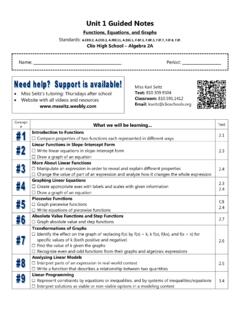Transcription of Precision Runway Monitor (PRM) Pilot Procedures
1 Precision Runway Monitor (PRM) Pilot Procedures Original Date: September 20, 2017 Contact: REV 1: Graphics enhanced pages 6, 7, 12, 14, 15, 16 3/15/2018 REV 2: Replaced 3000 with 2500 , pages 1, 12 5/5/2020 {1 PRM approaches are independent, simultaneous operations to runways spaced between 2500 and less than 4300 feet apart. The approach courses are normally parallel but may be offsetby between and degrees depending on the Runway separation. Chart examples not current{2 In the FMC, select ILS Y 22R to conduct the ILS PRM Y Rwy 22R; select RNAV (GPS) 10C to conductthe RNAV (GPS) PRM 10C.}}
2 PRM approaches require specific Pilot training. Refer to companyrequirements or, for general aviation, the Aeronautical Information Manual (AIM). Chart examples not current3 The chart at the left combines all of the textand symbols that appear on both an ILS and ILS PRM chart. 2. Text in red appears only on the PRM chart. Procedure NA when glide slope not available. Dual VHF COMM additional requirements on AAUP. Attention All Users Page (AAUP) is published for each airport where PRM approaches are conducted. 5. It is required to brief the Generalairport Procedures and those Runway Specificapplicable to the approach that is to be conducted.
3 4 The chart note Dual VHF comm. required refers to use of the Tower frequency and concurrently a secondary PRM Monitor frequency to protect against a blocked breakout instruction. The tower transmits on both. The aircraft transmits only on the tower frequency but listens to both. Jeppesen depictionFAA depiction5 Tune a secondary communication radio to the PRM frequency (or, if silent, to another, ATIS), set the volume as desired,retune if necessary to the PRM frequency, then deselect the secondary audio. When switched to the tower, re-select the secondary radio audio. Monitor controller overrides both the tower and PRM the Monitor controller s breakout instruction is blocked on the tower frequency, it can still be heard on the PRM frequency.
4 6 One No Transgression Zone (NTZ) Monitor Controller and one Tower Controller are assigned to each PRM Runway . The monitors watch for off course deviations, especially those toward the NTZ. If an aircraft strays off course , the Right Monitor will attempt to return the aircraft to the final approach course. West Central 1502 turn right return to the localizer course 02L 02R7 Though issuance is rare, the breakout instruction will begin with the words Traffic Alert, followed by: -aircraft call sign -a turn-climb (normally) or descend (rarely). Climb Traffic Alert Trans Global 574 heavy turn left immediately heading 340 climb and maintain 4000 Descend Traffic Alert Trans Global 574 heavy turn left immediately heading 340 descend and maintain 1900 Pilots must assume that a conflict is developing and execute this instruction without delay.
5 Thus, ALL breakouts are Hand Flown. Because breakouts are rare, before conducting a PRM approach, the AAUP reminds pilots to brief their aircraft specific Procedures , covering such topics as Autopilot, Flight Director, pitch, roll and power. 02L 02R8 If, during a breakout, TCAS issues a climb or descend Resolution Advisory (RA) opposite to the controller s instruction, follow the TCAS RA while executing the turn portion of controller s instruction. Monitor Controller: ..turn left heading 340descend and maintain 1900 Monitor Controller: ..turn left heading 340,climb and maintain 4000 9 PRM Questions(Answers at the bottom of the page)Question 1 When conducting closely spaced PRM approaches, the secondary Monitor frequency is:a.
6 Always used by the Pilot to transmit to ATCb. sometimes used by the Pilot to transmit to ATCc. never used by the Pilot to transmit to ATC Question 2 Pilots may fly a PRM approach:a. using the Autopilot or Flight Director throughoutb. using the Autopilot or Flight Director, but a breakout must be hand flownc. only be hand flown throughout Answer 1: c. Pilots never transmit on the Monitor frequency, they only receive transmissions on 2: b. The approach itself is to be flown using the flight director or the autopilot, but a breakout must always be hand 3 You briefed an ILS PRM approach and as ATC vectors your aircraft, you are informed that PRM approaches are no longer being conducted, expect the ILS approach to the same Runway .
7 You should?a. request a delaying vector in order to brief the ILS approachb. request an RNAV (GPS) approachc. continue the approach, because, having briefed the ILS PRM approach, you have completed the requirementsto conduct the ILS approach to the same runwayQuestion 4 During a breakout, a Pilot should follow a TCAS RA even if it is opposite the climb/descend ATC clearance:a. falseb. true c. at the Pilot s discretion Answer 3: c: Briefing a PRM approach also briefs the same Runway ILS or RNAV (GPS) approach, provided the same vertically guided minimums are utilized. The chart notes that apply to PRM operations may be ignored. Answer 4: b: If an RA is received, its instruction supersedes the controller s climb/descend clearance.
8 However, the Pilot should still follow the ATC turn instruction and inform ATC of the 5. At an airport where the PRM Runway ILS glideslope is reported out of service, you can still conduct a PRM approach if you are approved to:a. conduct a PAR or other ATC radar directed approach to that runwayb. conduct an RNAV (GPS) PRM approach to LNAV/VNAV or LPV minimums to that runwayc. cannot accept a PRM approach of any kind to that Runway Question 6. Briefing a climbing and descending breakout procedure for your aircraft before conductinga PRM is required and noted on the AAUP because: a. the closeness of the runways makes it essential that a breakout be properly executedb.
9 A breakout is an extremely rare event and hence pilots are not often required to execute onec. a breakout is an unexpected ATC clearance, and Pilot s should know ahead of time how they should conduct it Answer 5 b. You can conduct an RNAV (GPS) PRM approach to that Runway if you are approved for vertically guided RNAV approaches (LNAV/VNAV or LPV). Answer 6 a., b., c. Because pilots do not perform a breakout with regularity either in actual flight or in a flight simulator, it is critical to preplan the maneuver so that it can be executedcorrectly, in a timely in case! End PRM Approaches to Closely Spaced Runways12 Simultaneous Offset Instrument Approach (SOIA) Simultaneous Offset Instrument Approaches (SOIA) can be authorized when parallel Runway separation is less than 2500 feet and at least 750 feet.
10 SOIA approaches use one straight-in and one offset approach. 13 Straight-In ApproachOffset Approach At the offset approach missed approachpoint (MAP), aircraft leave the final approach course, and proceed visuallyto the airport. Normal maneuvering will establish the aircraft on the extended Runway centerline about 500 feet Above Ground Level (AGL). Chart examplesnot current14 The offset MAP establishes the end point of both the NTZ and instrument segment and the beginning of the visual segment. Prior to reaching the offset MAP, the Pilot must: -make visual contact with the straight-in to ATC that the traffic is in sight (ATC is NOT required to respondto this transmission).















